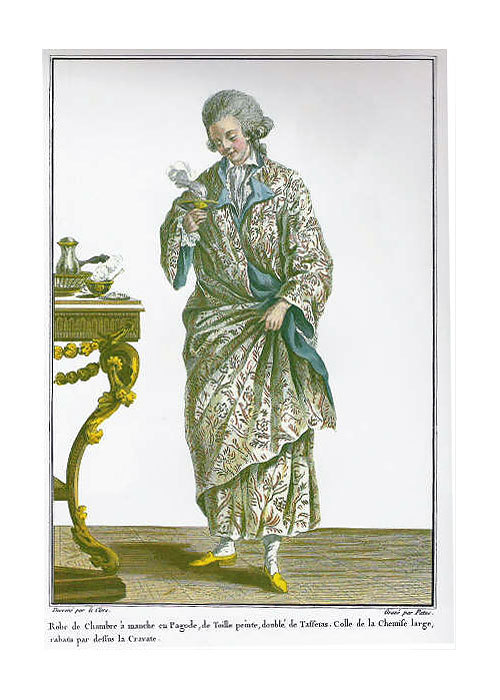my18thcenturysource:BanyanFor us, this is just a robe, but in the 18th century with fashion being so
my18thcenturysource:BanyanFor us, this is just a robe, but in the 18th century with fashion being so over the top, this was a key garment in a man’s wardrobe: inspired by East Indian style clothing and borrowing its name from the Hindu word for “trader”, this was what men wore at home. Or the street. Or at intellectual work. Basically anywhere they wanted to be comfortable at.The banyan (a.k.a. morning gown, Indian nightgown, wrapper, at-home robe, dressing gown, robes de chambre) started as a simple T shape full garment with no closing, almost floor length and sleeves that were folded to mock cuffs. Later on, actual cuffs, pockets and front buttons were added.Of course, this garment kept with it an air of exoticism not only in its shape but the fabrics: damasks, brocades, calico, chintz… everything that came together with the Chinoiserie decorations, the Indian spices and the Chinese tea. This was a whole look and lifestyle that required effort to keep but no effort at all to wear.Sometimes the banyan was worn with a matching waistcoat, but it could simply be worn over the breeches and shirt and with or without the usual waistcoat. To complete the look, a cap or headwear was added. Because why not.Images from top:Three banyans from the Met Museum.Yellow silk damask banyan, ca. 1780, Great Britain, Met Museum.Light blue and beige silk brocade banyan, ca. 1730, France, Met Museum.Striped blue, white and yellow silk banyan, second half of the 18th century, Europe, Met Museum.“Portrait of an unknown man”, about 1730-40, Carle Van Loo, France, Château de Versailles.Floral silk brocade banyan, 1735-40, cut about 1780, France, Royal Ontario Museum.Grey cannetillè silk banyan, ca. 1765, France, LACMA.Fashion plate of “Robe de Chambre”, ca. 1775, France.Printed cotton banyan, ca. 1750, made in India for the European market, LACMA.Blue silk damask Banyan with block printed lining, ca. 1750 (reproduction from Norah Vaugh’s book The cut of men’s clothes), via Duran Textiles.Pattern of Man’s At-home Robe (Banyan), about 1750–60, LACMA. Click and download the pattern from the LACMA website :) -- source link
Tumblr Blog : my18thcenturysource.tumblr.com
#banyans#18th century#extant garments#paintings#fashion#patterns









